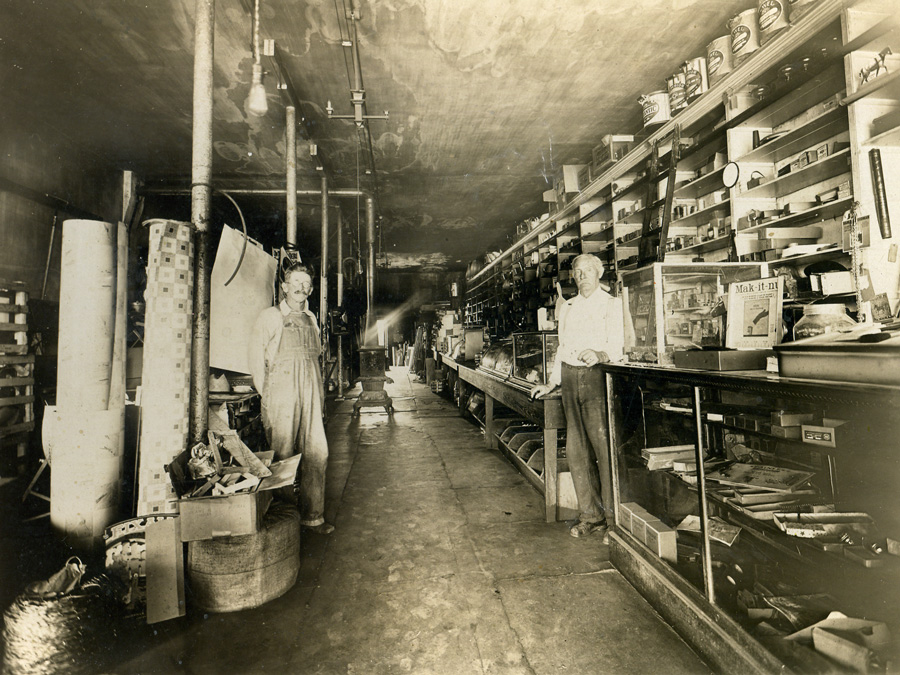NOBLE.
Located in Cleveland County, Noble is situated on U.S. Highway 77 near the east bank of the Canadian River approximately six miles south of Norman. Prior to the Land Run of 1889 the area stood in the Unassigned Lands. Ranching, conducted by Montford Johnson and Charles Campbell, among others, dominated the region's economy before its general settlement. Albert Rennie planned the town, claiming the 160-acre townsite during the run and convincing the Southern Kansas Railway (sold to the Atchison, Topeka and Santa Fe Railway in 1899), to locate a station there. The railway had built tracks through the area in 1886–87. Rennie named the town Noble to honor U.S. Secretary of the Interior John W. Noble. The community had hoped to gain the county seat, but the Norman townsite attracted more businesses. In July 1889 the Post Office Department designated a Noble post office, with Rennie serving as postmaster. In January 1891 the townsite was surveyed and platted.
By August 1890 the town had a lumber company, a butcher, a livery, a grocer, two blacksmiths, a druggist, a hardware store, a hotel, two general stores, three doctors, and a newspaper, the Noble Democrat. Soon after the village was established, a cotton gin served the area farmers. In 1898 the Oklahoma College Experiment Station built and installed a cattle-dipping vat at the town to bathe cattle entering Oklahoma Territory. This helped prevent the spread of Texas fever. Charles E. Garee and others formed the Canadian River Bridge Company, which in 1898 built a suspension bridge over the South Canadian River. The flooding river destroyed the bridge in 1903 or 1904. Garee, an award-winning horticulturist, operated the Noble Nursery from the late 1890s, with his father, F. A. Garee, into the 1960s. In 1900 the population stood at 349; it climbed to 403 in 1910. In 1902 the bank received its charter, and by 1911 a jeweler and a feed mill also served the town. The Noble Courier, the Noble Picayune, the Star of Hope, the Noble Weekly Journal, the Record, the Cleveland County Leader, and the Noble News were early newspapers.
In 1920 Noble's population was 497, but it declined to 463 in 1930. In 1940 there were 536 inhabitants. By 1946 the bank had successfully survived the Great Depression, and several retail outlets, a feed mill, the nursery, and the Smith Brothers Road Contractors, established in 1918, operated in the town. The population began a steady ascent, reaching 724 in 1950 and 995 in 1960. As the 1970s approached the population boomed. With 2,241 residents in 1970, Noble became a "bedroom" community for Norman and Oklahoma City. More businesses emerged. In 1979 Award Design Medals, Incorporated, opened and was the largest employer for several years. The company manufactured specialty belt buckles (often for the rodeo circuits), medallions, and figurines before closing in 2001. In 1970 the Brockhaus Nursery purchased Garee's Noble Nursery. In the 1980s Noble continued to prosper, adding seven businesses in 1982. The 1980 population stood at 3,497 and climbed to 4,710 in 1990. In 1992 the Thunder Valley Raceway Park opened, providing drag-racing entertainment.
Noble's education system dates to 1890, when a subscription school operated for a few months. In 1891 the Noble Academy opened and boarded students from throughout the territories and as far away as Texas. The institution closed in 1895. In 1897 the town constructed a public school, which operated only sporadically, because of insufficient funding. In 1911 the community built a high school. The school district received an influx of students in the 1940s as rural schools consolidated. In 1970 a new high school building met the needs of an expanding student body. In 2000 the kindergarten-through-twelfth-grade enrollment was 2,678.
In 1984 Gov. George Nigh designated Noble "the Rose Rock Capital." Rose rock (barite rosette) is a rare rock that can be found in central Oklahoma, Kansas, California, and Egypt. Annually in May Noble hosts the Rose Rock Festival, and in 1986 a rose rock museum was established. In 2000 the community's population stood at 5,260 and in 2010, at 6,481. The April 2020 census reported 6,985 residents.
See Also
Learn More
May Klinglesmith Brosius, Merle Austin Turner, and Mary Leslie Ishmael, A Symposium of Noble, Oklahoma (Noble, Okla.: Noble Future Homemakers of America, 1957).
Bonnie Speer, Cleveland County: Pride of the Promised Land: An Illustrated History (Norman, Okla.: Traditional Publishers, 1988).
John Womack, Cleveland County, Oklahoma: Historical Highlights (Noble, Okla.: Privately printed, 1983).
Citation
The following (as per The Chicago Manual of Style, 17th edition) is the preferred citation for articles:
Larry O'Dell, “Noble,” The Encyclopedia of Oklahoma History and Culture, https://www.okhistory.org/publications/enc/entry?entry=NO002.
Published January 15, 2010
Last updated March 25, 2024
© Oklahoma Historical Society


